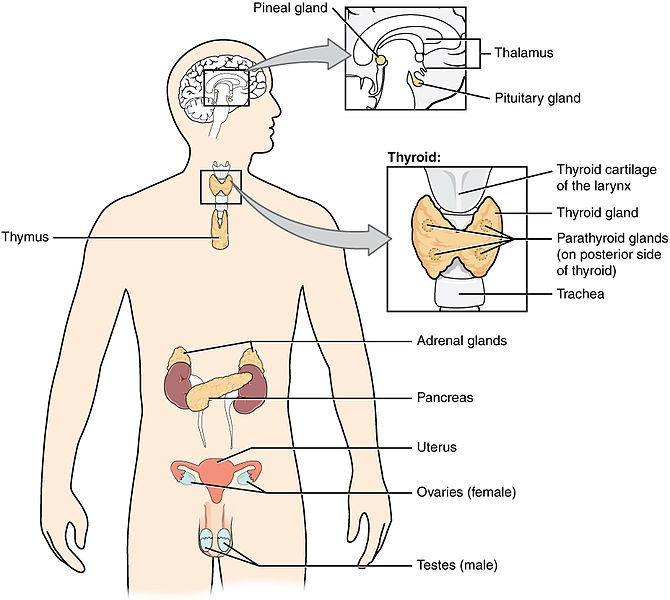M
Meriem Bazine
AP Environmental Science ♻️
252 resourcesSee Units
Overview of Endocrine Disruptors
Certain chemicals produced naturally or through human activity affect the ecosystem in a negative way.

Image Courtesy of Pexels
What are Endocrine Disruptors?
Endocrine disruptors are manmade or naturally occurring chemicals that affect the hormones within your body, also known as your endocrine system.

Image Courtesy of Wikimedia
What is the Endocrine System?
The endocrine system has to do with your hormones, more specifically the glands within your body that do not have ducts or structures like ducts. This system includes ovaries or testes, parathyroid glands, adrenal glands, pituitary gland, pineal body, pancreas, and hormone-releasing cells in the GI tract, kidney, heart, and placenta. These specific glands release chemicals called hormones.
Examples of Hormones in the Endocrine System
- Adrenocorticotropic hormone (ACTH): This hormone is secreted by the pituitary gland in order to control the réalisé of the adrenal glands’ corticosteroid hormones.
- Thyroid hormones: These hormones are produced in the thyroid gland and influence basically every cell in your body’s function from growth to development to metabolism.
- Antidiuretic hormone, vasopressin (ADH): This hormone is made by the pituitary gland in order to stimulate water réabsorption by your kidney tubules.
- Insulin
- Epinephrine (adrenaline) and Norepinephrine (no adrenaline): These two hormones are created in the adrenal glands so that under stressful conditions the body can react properly.
- Testosterone: This hormone is created by the adrenal gland, testes, and ovaries and is a male sex hormone.
- Estrogen: Estrogen is created by the ovaries and is a female sex hormone.
Where are Endocrine Disruptors Found?
Despite how harmful they are, endocrine disruptors can be found in many of the items you use daily, such as plastic items, foods, and pesticides! Some of the most common disruptors include BPA, triclosan, and perchlorate. On products such as water bottles or containers, you might see labels that say “BPA Free”, meaning that those products are free of that endocrine disruptor.
Endocrine Disruptors Affect Ecosystems
Within animals in the ecosystem, endocrine disruptors can cause unusual growth patterns and issues with reproduction. For humans, there is an increased risk of certain ailments and reproductive problems. Birth defects, gender imbalance, and issues with development can occur within both aquatic and land organisms.
Plastic items with BPA that are used by humans can end up in the oceans, where they are ingested by wildlife who are now subject to the effects of the endocrine disruptor 😔. Some endocrine disruptors take a very long time to break down, leading to further damage as more organisms come into contact with the item.
It is important to note that it is difficult to find the exact causes or endocrine disruptors that cause these issues because organisms can be exposed to many endocrine disruptors at one time, making the effects difficult to study. 🤔
Effect on Wildlife
Endocrine disruption within wildlife has more concrete evidence, perhaps due to higher levels of exposure. Some effects of exposure to endocrine disruptors within wildlife are egg thinning in birds, imposex mollusks (when females have male genitalia), feminization in freshwater fish that are exposed to treated sewage outflow, and changes in the reproduction of certain alligators and turtles. Possible effects that have less solid evidence are reproductive issues in whales, seals, and polar bears, hindered immune system function within seals, and frogs with abnormal skeletal structures.
Effect on Humans
Normally, the body’s endocrine system causes little changes in the levels of hormones. However, these seemingly small changes can lead to big effects developmentally as well as biologically. Endocrine disruptors may have caused evident changes in patterns of human health over later decades. Some examples of these changes are an increase in genetic deformities within males, a higher occurrence of certain hormonally linked cancers, and the lowering of sperm count within some areas of the world. Albeit more scientifically controversial, there may also be a link between endocrine disruptors and neural formation or sexual practices.
This information results in the understanding that even if there is only a small amount of endocrine-distrusting chemicals, they may still be considered dangerous. There needs to be more research done on how endocrine disruptors potentially affect specific aspects of human health, the mechanisms behind endocrine disruptors, the mixing of different endocrine disruptors, prolonged low-dose exposure, exposure to those of varying ages, and exposure to humans that may have a higher susceptibility to endocrine disruptors.
Examples of Endocrine Disruptors
- Bisphenol A (BPA): This endocrine disruptor is used to create polycarbonate plastics as well as epoxy resin. It is commonly found in plastic food storage containers.
- Triclosan: These endocrine disruptors can be found in a couple of antimicrobial and/or personal care products such as body wash in liquid form.
- Dioxins: This endocrine disruptor is a byproduct of herbicide production as well as paper bleaching. It is also released when waste is burnt and during wildfires.
- Polychlorinated biphenyls (PCB): This endocrine disruptor is used when creating electrical equipment such as transformers as well as in hydraulic and heat transfer fluids, lubricants, and plasticizers.
- Perchlorate: This endocrine disruptor is the byproduct of the pharmaceutical industry, aerospace, and weaponry and is found in drinking water and fireworks.
- Polybrominated diphenhydramine enters (PBDE): This endocrine-disrupting chemical is used to create flame retardant household products.
- Perfluoroalkyl and Polyfluoroalkyl Substances (PFAS): This endocrine disruptor is used within industrial spheres for firefighting foams, nonstick pans, paper, textile coating, and other products.
- Phytoestrogens: This endocrine disruptor can be found in plants that have activities that are hormone-like. Some examples are genistein and daidzein in soy products such as tofu.
- Phthalates: These endocrine disruptors are used to make more flexible plastic as well as in some food packages, medical devices, toys for children, and cosmetics.
Further Information on Chapter 8 🤓:
Browse Study Guides By Unit
🏜Unit 1 – The Living World: Ecosystems
🐠Unit 2 – The Living World: Biodiversity
👪Unit 3 – Populations
🌏Unit 4 – Earth Systems & Resources
🏖Unit 5 – Land & Water Use
⚡️Unit 6 – Energy Resources & Consumption
💨Unit 7 – Atmospheric Pollution
♻️Unit 8 – Aquatic & Terrestrial Pollution
🔥Unit 9 – Global Change
📚Study Tools
🤔Exam Skills

Fiveable
Resources
© 2025 Fiveable Inc. All rights reserved.